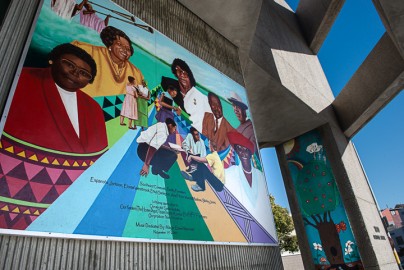Southeast center stands tall Murals express community’s commitment for access to education

By Alex Reyes
The Guardsman
City College’s Southeast campus is living proof of a village of people joining together to take care of their own.
Southeast is an academic campus, to be sure, but it is so much more than even that noble endeavor. The first signal that the Bayview-Hunters Point neighborhood location is more than the sum of its parts is seen on a sign near the top of the Oakdale Avenue entrance reading, “Southeast Community Facility Commission.”
The commission was the result of an ordinance by the Board of Supervisors in 1987 to oversee the Southeast facility, which was built after an agreement in 1952 between the San Francisco Public Utilities Commission and the Bayview-Hunters Point community.
The PUC wanted to build a massive sewage treatment plant in the neighborhood—which now extends from LaSalle to Evans Avenues and from Palou to Rankin Avenues—and agreed to build the community an educational facility as an attempt to mitigate the negative effects of the sewage plant.
The commission’s goal, according to the City of San Francisco’s website, is to “further the gainful employment of residents in the Bayview-Hunters Point community; create opportunities for them to participate in educational programs, establish and expand opportunities for children’s day care; and provide information and resources for the enhancement and growth of the community as a whole.”
The commission’s mission is validated by the message, “Southeast Campus/Where Education and Employment Connect,” which is written in white lettering on a green wall leading from the front lobby to an atrium.
Effervescent City College student Robyn Buckins, who staffs the campus’ front desk, read through the roster of organizations that rent office space in the building alongside City College, which occupies the fourth floor.
CalWorks, the state welfare program.
Girls 2000, a nonprofit organization. Hunter’s Point Family, another nonprofit.
Head Start, a daycare center run by San Francisco State University.
San Francisco government’s Human Services Agency.
Renaissance, a youth employment organization that works closely with the Human Services Agency’s One Stop Career Center, which is also located at Southeast campus.
Buckins introduced me to Jeff Williams, a worker in the Career Center, who told me they are attempting to establish a General Equivalency Degree training program at Southeast campus.
Williams then introduced me to Center Manager Edwin Florentino.
We looked down onto the ground floor of the atrium where 35 to 40 people were participating in a Step Forward employment program meeting.
Florentino said that Step Forward, which helps unemployed people on public assistance to find work, is a result of the federal Jobs Now program embedded in the American Recovery and Reinvestment Act of 2009.
“We were able to tell employers that we would pay 100 percent of the salary for one year for those who were hired through this program,” Florentino said. “The employers were so grateful. In the first year 4,000 people were hired.”
Florentino walked over to windows looking out at the Alex Pitcher Jr. Community Center while one-on-one conversations were taking place at tables set along two walls of the hall.
“People are being interviewed at the tables,” Florentino said, as he pointed out representatives for San Francisco’s Department of Public Works and the city’s Park Rangers. “Sometimes the employers compete for the same prospect.”
Florentino said approximately 2,000 people found work in 2012 through the program and talked about the GED training program.
“It makes sense,” Florentino said, shrugging. “Doesn’t it?”

Comments are closed.